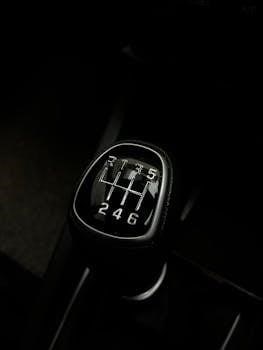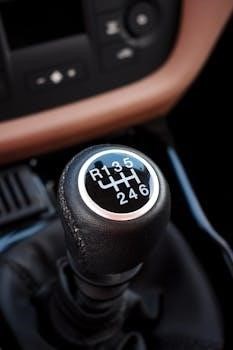The Ford C6 transmission‚ a robust automatic‚ was introduced in the mid-1960s. It quickly became popular for heavy-duty applications in Ford trucks and performance cars. Known for its durability‚ it gained a reputation for handling high torque‚ making it a reliable choice.
Overview of the Ford C6 Transmission
The Ford C6 transmission‚ while often associated with automatic applications‚ is a robust three-speed unit designed for heavy-duty use. Introduced by Ford in 1966‚ it quickly became a staple for vehicles requiring significant torque capacity‚ particularly those equipped with larger V8 engines. Though commonly found as an automatic‚ its design and construction principles are relevant when considering manual alternatives or modifications. The C6’s rugged nature makes it a popular choice for those seeking a durable transmission platform‚ even in modified or custom applications. Its reputation for being nearly indestructible has led to its continued use in various forms‚ including modified manual setups‚ for performance purposes. The C6’s architecture and robust internal components are a key factor in its adaptability.

C6 Transmission History and Production
The C6 transmission was produced by Ford from 1966 to 2004‚ known as the SelectShift Cruise-O-Matic. It was designed for high torque applications and saw widespread use in trucks and cars with larger engines.
Years of Production and Applications
The Ford C6 transmission’s production spanned from 1966 to 1996‚ with some sources extending it to 2004. It was primarily employed in Ford vehicles requiring a heavy-duty automatic transmission. This included a wide range of trucks‚ from light-duty pickups to larger models‚ and various cars‚ especially those equipped with high-performance V8 engines. The C6’s robustness made it suitable for applications that generated significant torque‚ solidifying its place in Ford’s lineup for many years. Its longevity in production speaks to its reliability and adaptability across diverse vehicle types‚ cementing its legacy as a dependable transmission.
Evolution from the MX Transmission
The Ford C6 transmission was designed as an improvement over its predecessor‚ the MX transmission. The C6 offered a significant reduction in weight and complexity compared to the MX. It also minimized parasitic power loss‚ allowing for more efficient transfer of power to the wheels. Furthermore‚ the C6 boasted an increased torque capacity‚ making it suitable for larger‚ more powerful engines. Despite these enhancements‚ the C6 maintained similar packaging dimensions to the MX. This evolution allowed Ford to provide a more robust and efficient transmission without major design alterations to the vehicles it was installed in‚ marking a significant step forward in transmission technology.

Technical Specifications of the C6
The C6 transmission‚ a 3-speed automatic‚ was designed to handle up to 475 lb-ft of torque. Aftermarket upgrades can significantly increase this capacity. It features specific gear ratios and shift characteristics.
Torque Capacity and Performance Specs
The Ford C6 transmission‚ known for its robust design‚ was engineered to handle substantial torque‚ originally rated for around 475 lb-ft. This made it suitable for pairing with larger V8 engines. However‚ the C6’s torque capacity can be greatly enhanced through aftermarket modifications. Units specifically prepared for drag racing are capable of withstanding significantly more than the factory specification. The transmission’s inherent strength and durability are key factors in its continued popularity within performance-oriented applications. These modifications often involve strengthening the internal components and optimizing shift characteristics to match the demands of high-performance driving. The transmission’s ability to handle this increased torque is a testament to its solid base design.
Gear Ratios and Shift Characteristics
The C6 transmission features a three-speed automatic design‚ with gear ratios of 2.40⁚1 for first gear‚ 1.40⁚1 for second‚ and 1⁚1 for third. These ratios contribute to the transmission’s smooth and predictable shift patterns. The C6 was designed to provide automatic upshifts and downshifts‚ operating using hydraulic principles. While known for its robust build‚ the factory shift characteristics can be described as somewhat soft and not overly aggressive. For performance applications‚ shift kits and valve body modifications are often used to firm up shifts‚ reduce slippage‚ and enhance overall responsiveness. These modifications cater to drivers seeking a more positive and engaging driving experience from their C6 transmission.
C6 vs C4 Transmission Comparison
The Ford C6 and C4 transmissions‚ while both automatics‚ have key differences. The C6 is heavier and stronger‚ designed for high-torque applications‚ whereas the C4 is lighter and more suited for smaller engines.
Key Differences in Design and Function
The C6 and C4 transmissions‚ despite both being Ford automatics‚ diverge significantly in design and function. The C6‚ engineered for heavy-duty use‚ boasts a larger case and more robust internal components‚ enabling it to handle greater torque from big-block V8 engines. In contrast‚ the C4 was designed for lighter-duty applications and smaller engines‚ featuring a more compact design and less internal mass. Functionally‚ the C6‚ with its increased strength‚ is better suited for high-performance and demanding tasks such as towing and drag racing‚ while the C4 is more commonly found in lighter vehicles. The C6 has a higher capacity and larger size‚ adding more weight. These design variations result in different performance and applications.
Physical Identification of C4 and C6
Distinguishing between a C4 and C6 transmission can be achieved through careful visual inspection‚ despite their similar appearance. A key difference lies in the case size; the C6’s heavy-duty nature means it’s noticeably larger than the C4. Specifically‚ the C6 features an integral bellhousing‚ whereas the C4’s bellhousing is detachable. The pan shape also differs⁚ the C6 has a more rectangular pan with a distinctive “bump” on the passenger side‚ while the C4’s pan is more square. Additionally‚ the C6’s vacuum modulator is located on the passenger side‚ while the C4’s is found on the driver’s side. These visual cues aid in quickly and accurately identifying each transmission.
C6 Transmission Performance and Modifications
The C6 transmission is renowned in drag racing and off-road applications due to its strength. Modifications such as shift kits and aftermarket upgrades further enhance its performance and durability.
Use in Drag Racing and Off-Road Applications
The Ford C6 transmission’s robust design has made it a favored choice in both drag racing and off-road scenarios. Its inherent strength allows it to withstand the demanding conditions of high-torque applications. Racers often equip C6 units with manual valve bodies and transbrakes to gain enhanced control over gear shifts‚ optimizing performance on the drag strip. The C6’s reputation for being nearly indestructible also lends itself perfectly to the rigors of off-road driving‚ where its durability is a major advantage‚ making it a popular selection for modified trucks and off-road vehicles. Its ability to handle the punishment of both high-performance and rough terrain contributes to its continued presence in these demanding environments.
Shift Kits and Aftermarket Upgrades
For those seeking enhanced performance from their C6 transmission‚ various shift kits and aftermarket upgrades are available. These modifications aim to improve shift quality‚ firmness‚ and speed. Shift kits typically include valve body modifications‚ recalibrated springs‚ and other components to provide quicker‚ more decisive shifts. Additionally‚ aftermarket upgrades such as high-performance clutches‚ stronger bands‚ and improved torque converters can further enhance the transmission’s ability to handle increased power and torque. These upgrades are commonly utilized by enthusiasts and racers to customize the C6’s behavior for specific applications‚ improving its capabilities beyond the stock configuration. Ultimately‚ these modifications are intended to optimize performance and ensure reliability under increased stress.

Common Issues and Maintenance
Common C6 issues include filter blockages‚ pump problems‚ and vacuum modulator malfunctions. Proper maintenance‚ using the correct fluid‚ and regular checks are crucial for prolonged transmission life and optimal performance.
Troubleshooting Common Problems
When experiencing issues with a C6 transmission‚ several common problems might be the culprit. A blocked transmission filter can restrict fluid flow‚ leading to poor shifting and potential damage. Transmission pump problems can result in insufficient hydraulic pressure‚ affecting overall performance. A faulty vacuum modulator can cause erratic shifting or a lack of downshifting. Additionally‚ a bad torque converter may cause slipping or shuddering. Improperly adjusted clutches or bands can also contribute to shifting problems. It’s essential to diagnose these issues systematically‚ often requiring a detailed inspection of the transmission components to pinpoint the exact cause.
Fluid Capacity and Maintenance
Maintaining the correct fluid level and condition is crucial for the longevity of the C6 transmission. Typically‚ a complete fill requires around 12 quarts of automatic transmission fluid (ATF)‚ although this can vary depending on the vehicle and cooler setup. Using the proper type of ATF is essential for smooth operation and to prevent damage. Regular fluid checks and changes‚ typically every 30‚000 to 50‚000 miles‚ are recommended‚ and more often under heavy use or in performance applications. Inspecting for leaks and addressing them promptly can prevent fluid loss and potential transmission failure.

C6 Transmission in Various Vehicles
The C6 transmission was widely used in Ford trucks and cars‚ particularly those with larger V8 engines. Its robust design made it suitable for both heavy-duty and performance applications across multiple models.
Applications in Ford Trucks and Cars
The Ford C6 transmission found extensive use across a variety of Ford vehicles‚ primarily in trucks and larger cars during its production years. It was a standard option in many of Ford’s heavy-duty trucks‚ including the F-Series‚ where its strength and reliability were crucial for hauling and towing. In cars‚ the C6 was commonly paired with big-block V8 engines in models like the Mustang‚ Torino‚ and various full-size sedans‚ offering a robust solution for higher torque applications. This widespread adoption highlights the C6’s versatility and Ford’s confidence in its ability to handle diverse performance demands. It served as a workhorse in both utilitarian and performance-oriented vehicles‚ solidifying its place in Ford’s history.
Installation and Crossmember Considerations
Installing a C6 transmission often requires careful consideration of crossmember modifications or replacements. The C6’s larger size and different mounting points compared to other transmissions mean that existing crossmembers in many vehicles may not align properly. Fabricating a custom crossmember or using an aftermarket adjustable option is often necessary to ensure proper transmission support and driveline angles. It is also important to ensure adequate clearance around the transmission for proper installation and future maintenance. The crossmember needs to be robust enough to handle the weight and torque of the C6 transmission. This attention to detail is crucial for a successful and trouble-free installation. The correct mounting and support are key to preventing issues and ensures optimal operation.

Leave a Reply
You must be logged in to post a comment.